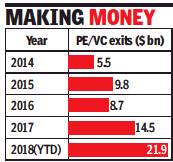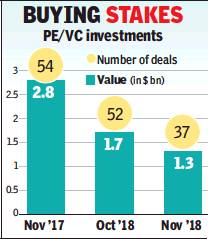Private equity investments/ Venture Capital Funding in India
(→Private equity investments in India) |
(→Private equity investments in India) |
||
| Line 33: | Line 33: | ||
''Private equity investments in India, 2003-17'' | ''Private equity investments in India, 2003-17'' | ||
| + | |||
| + | =Returns on exited investments= | ||
| + | ==8% in 2006–2008; 22% in 2012–2014== | ||
| + | [https://epaper.timesgroup.com/Olive/ODN/TimesOfIndia/shared/ShowArticle.aspx?doc=TOIDEL%2F2018%2F12%2F04&entity=Ar01906&sk=F65FF82E&mode=text Sindhu Hariharan, PEs’ returns jump to 22% from 8% in 5 yrs, December 4, 2018: ''The Times of India''] | ||
| + | |||
| + | [[File: PE- VC investments- 2017, 2018.jpg|PE/ VC investments: 2017, 2018 <br/> From: [https://epaper.timesgroup.com/Olive/ODN/TimesOfIndia/shared/ShowArticle.aspx?doc=TOIDEL%2F2018%2F12%2F04&entity=Ar01906&sk=F65FF82E&mode=text Sindhu Hariharan, PEs’ returns jump to 22% from 8% in 5 yrs, December 4, 2018: ''The Times of India'']|frame|500px]] | ||
| + | |||
| + | ''Buyout Deals Most Rewarding, Finds Study'' | ||
| + | |||
| + | As optimism grows about the Indian alternate investment landscape, the country’s private equity (PE) industry is getting more rewarding for investors, a report has said. More specifically, PE investments in the last five years have fetched higher returns than ones made earlier. | ||
| + | |||
| + | “Average returns on exited investments have risen from 8% from the 2006–2008 vintage to 22% in the 2012–2014 vintage,” says the ‘Indian Private Equity: Coming Of Age’ report by McKinsey, which analyses a dollar internal rate of return (IRR) for a sample of 654 PE exits between 2003 and 2017. | ||
| + | |||
| + | The report also notes that buyout strategies (a deal in which majority ownership is acquired) earned the best returns for PE players with median returns at 21%. “Several private equity firms shifted focus from minority positions to buyouts, where they have greater control of strategy and talent as well as influence on the manner and timing of exits,” the report says. From 2015 to 2017, almost a quarter of total PE investments were in buyouts — up sevenfold in value from the 2009-2011 period. | ||
| + | |||
| + | Consumer goods, financial services, healthcare, IT/BPO, machinery & industrials and telecom collectively accounted for 83% of total PE investment from 2015 to 2017, compared to 44% share during the 2009-2011 period. Sectors that contributed the most to improving returns were financial services, consumer goods and machinery products as median returns in these were in the 15-21% range, with telecom pulling down performance for PE investors by recording a 3% median IRR. | ||
| + | |||
| + | The study also observes a trend of out-performance among companies backed by PE capital. In a reinforcement of the industry’s hunt for “alpha” ventures, the report says businesses with PE backing grew faster than industry averages, raising revenue and profit on an average 27% faster than their peers. | ||
| + | |||
| + | EY India partner and national leader for PE services, Vivek Soni, believes there is a high degree of correlation between fund managers closing follow-on funds and industry performance. “Those general partners (GPs) that are able to deliver returns will find it easier to raise follow-on funds, and this along with increasing numbers of total funds under management with GPs is an indication of improving returns,” he says. | ||
| + | |||
| + | “The growing pace of exits in the last few years with sustained growth is a big positive as Limited Partners previously cited the lack of exits as perhaps the biggest issue faced by them when investing into India,” says IVCA chairman and Tata Opportunities Fund managing partner Padmanabh Sinha. “The fact that exits are being achieved through a balanced mix of capital markets, strategic sales and sales to financial sponsors is also reassuring the availability of multiple exit options,” he adds. | ||
| + | |||
| + | For instance, industry watchers see recent exits’ track record of PE firms like Chrys Capital and Kedaara Capital as indicators of improving performance. Further, a fund-raise of around $600 million by True North Capital (one of the country’s earliest homegrown PE funds) for its latest Fund VI also supports the trend. | ||
| + | |||
| + | However, accessing performance data on PE and VC funds continues to be a challenge as regulations on disclosing returns are not too well developed. EY’s Soni considers the space to be “evolving” in that aspect, and says the trait of “survivor bias” currently characterising the space could change as the market matures. | ||
=See also= | =See also= | ||
Revision as of 13:31, 22 December 2018
This is a collection of articles archived for the excellence of their content. |
Contents |
Exit of private equity/venture capital (PE/VC)
2014-18

From: Aparna Desikan, At $22bn, 2018 sees most exits by PE/VCs till date, September 8, 2018: The Times of India
Calender 2018 is turning out to be the biggest year for private equity/venture capital (PE/VC) exits. Driven by the Walmart-Flipkart deal, the year has so far seen nearly $22 billion worth of exits till date through more than 160 deals, according to data from research firm Venture Intelligence. While 2017 saw $14.5 billion for the whole year, previous years saw less than $10 billion.
Analysts point out that while the Flipkart deal contributed to a chunk of the deal size in terms of value, the mood among investors also favours exits. “IPOs, M&A exits and acqui-hires have contributed to the 165 deals so far. Among IPOs, the engineering firm Varroc went public where Tata Capital sold its entire stake in the company. AU finance saw Kedaara Capital and Warburg making a partial exit,” said Venture Intelligence MD Arun Natarajan.
With unicorns raising funds and consequently giving exits to smaller investors, there is an emergence of funds such as TR Capital and Madisson that concentrate mainly on secondary investments, paving the way for more exits. Fashion e-commerce player Nykaa saw TVS Capital sell its stake to Lighthouse Ventures in a Rs 113-crore deal and edtech startup Unacademy gave an exit with 150% internal returns to Waterbridge, which had invested $1 million in 2016.
Prime Venture Partners managing partner Sanjay Swamy said, “Additionally, investors from China and Japan entering the scene have increased the scope for early stage investors to see greater returns.”
And it is not just secondary and strategic investors that give profitable exits. Mature startups that acquire stakes for inorganic growth also have a role to play. Natarajan added even as exits remain on the higher side, the sentiment would be dependent on the behaviour of the Indian rupee and the public markets.
Private equity investments in India
2003-17

From: November 25, 2018: The Times of India
See graphic:
Private equity investments in India, 2003-17
Returns on exited investments
8% in 2006–2008; 22% in 2012–2014
Sindhu Hariharan, PEs’ returns jump to 22% from 8% in 5 yrs, December 4, 2018: The Times of India

From: Sindhu Hariharan, PEs’ returns jump to 22% from 8% in 5 yrs, December 4, 2018: The Times of India
Buyout Deals Most Rewarding, Finds Study
As optimism grows about the Indian alternate investment landscape, the country’s private equity (PE) industry is getting more rewarding for investors, a report has said. More specifically, PE investments in the last five years have fetched higher returns than ones made earlier.
“Average returns on exited investments have risen from 8% from the 2006–2008 vintage to 22% in the 2012–2014 vintage,” says the ‘Indian Private Equity: Coming Of Age’ report by McKinsey, which analyses a dollar internal rate of return (IRR) for a sample of 654 PE exits between 2003 and 2017.
The report also notes that buyout strategies (a deal in which majority ownership is acquired) earned the best returns for PE players with median returns at 21%. “Several private equity firms shifted focus from minority positions to buyouts, where they have greater control of strategy and talent as well as influence on the manner and timing of exits,” the report says. From 2015 to 2017, almost a quarter of total PE investments were in buyouts — up sevenfold in value from the 2009-2011 period.
Consumer goods, financial services, healthcare, IT/BPO, machinery & industrials and telecom collectively accounted for 83% of total PE investment from 2015 to 2017, compared to 44% share during the 2009-2011 period. Sectors that contributed the most to improving returns were financial services, consumer goods and machinery products as median returns in these were in the 15-21% range, with telecom pulling down performance for PE investors by recording a 3% median IRR.
The study also observes a trend of out-performance among companies backed by PE capital. In a reinforcement of the industry’s hunt for “alpha” ventures, the report says businesses with PE backing grew faster than industry averages, raising revenue and profit on an average 27% faster than their peers.
EY India partner and national leader for PE services, Vivek Soni, believes there is a high degree of correlation between fund managers closing follow-on funds and industry performance. “Those general partners (GPs) that are able to deliver returns will find it easier to raise follow-on funds, and this along with increasing numbers of total funds under management with GPs is an indication of improving returns,” he says.
“The growing pace of exits in the last few years with sustained growth is a big positive as Limited Partners previously cited the lack of exits as perhaps the biggest issue faced by them when investing into India,” says IVCA chairman and Tata Opportunities Fund managing partner Padmanabh Sinha. “The fact that exits are being achieved through a balanced mix of capital markets, strategic sales and sales to financial sponsors is also reassuring the availability of multiple exit options,” he adds.
For instance, industry watchers see recent exits’ track record of PE firms like Chrys Capital and Kedaara Capital as indicators of improving performance. Further, a fund-raise of around $600 million by True North Capital (one of the country’s earliest homegrown PE funds) for its latest Fund VI also supports the trend.
However, accessing performance data on PE and VC funds continues to be a challenge as regulations on disclosing returns are not too well developed. EY’s Soni considers the space to be “evolving” in that aspect, and says the trait of “survivor bias” currently characterising the space could change as the market matures.
See also
Financial Secrecy Index and India
Foreign currency inflows, outflows: India
Foreign Direct Investment (FDI): India
Foreign exchange reserves: India
Foreign Institutional Investment (FII): India
Foreign Portfolio Investors (FPI): India